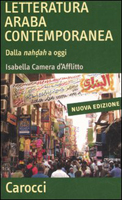| HOME | LITERATURES | TOPICS | BIBLIOGRAPHY | WHO WE ARE | EVENTS | LINKS |

Studies on Modern and Contemporary Arabic Literature |
|
|
Isabella Camera d'Afflitto Letteratura araba contemporanea. Dalla Nahda a oggi. Roma, Carocci, 2007, pp. 389 The "New Arabic Literature", as the great scholar Francesco Gabrieli called it, was born at the end of the 19th century in Egypt and the Syrian Lebanese area, boosted by a wider wave of cultural renewal, which had been fuelled by Western influences and a deep thrust towards the modernization of customs and societies. Strongly linked, at least at its beginnings, to the renewal of Arab classic culture, which revived after centuries of decadence, the new literature pointed to new directions in many different fields, from poetry to narrative and scholarly production as well, in an attempt to get rid of the past and to adapt to modern time's demands. This text is the first accomplished effort into arranging in Italian two centuries of literary and cultural history of the Middle East and Maghreb. It traces the stages of this great revival, which spanned through the development of printing press, the birth of newspapers and periodicals, the spread and circulation of poems and short stories, as well as of ideological querelles, all in a fragile balancing between the revival of the past and the attraction to modernity. This is, most of all, the history of Arab culture and society, thus the history of the female emancipation movement and of the strenuous quest for an identity based on language, thought and religion, destined to occupy an absolutely relevant place in the world's shape to come. Read the review by Hilary Kilpatrick on "Arabic and Middle Eastern Studies", January 2001, vol. 4, no.1
|
|